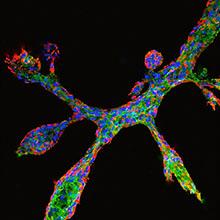A research group has developed an assay whereby cultured human breast epithelial cells rebuild the three-dimensional tissue architecture of the mammary gland.
A transparent gel is used in which cells divide and spread, similar to the developing mammary gland during puberty. Specifically, cells divide and generate hollow ducts that form a network of branches and terminate in grape-like structures. Throughout the reproductive lifespan of a woman, the mammary gland is constantly remodeled and renewed in order to guarantee milk production even after multiple pregnancies.
Although their exact identity remains elusive, this high cellular turnover requires the presence of cells with regenerative capacity, i.e. stem cells. Breast cancer cells can adopt properties of stem cells to acquire aggressive traits. To determine how aggressive traits arise in breast cancer cells, it is therefore crucial to first elucidate the functioning of normal breast stem cells. The work led by Dr. Christina Scheel provides a new experimental tool.

Detail of breast epithelial cells in culture undergoing ductal elongation and side-branching. Credit: Image: Haruko Miura Copyright: Helmholtz Zentrum Munich
Using their newly developed organoid assay, the researchers observed that the behavior of cells with regenerative capacity is determined by the physical properties of their environment. Jelena Linnemann, first author of the study, explains, "We were able to demonstrate that increasing rigidity of the gel led to increased spreading of the cells, or, said differently, invasive growth. Similar behavior was already observed in breast cancer cells. Our results suggest that invasive growth in response to physical rigidity represents a normal process during mammary gland development that is exploited during tumor progression." Co-author Lisa Meixner adds that „with our assay, we can elucidate how such processes are controlled at the molecular level, which provides the basis for developing therapeutic strategies to inhibit them in breast cancer."
Another reason the mini-mammary glands represent a particularly valuable tool is, because the cells that build these structure are directly isolated from patient tissue. In this case, healthy tissue from women undergoing aesthetic breast reduction is used. Co-author Haruko Miura explains: "After the operation, this tissue is normally discarded. For us, it is an experimental treasure chest that enables us to tease out individual difference in the behavior of stem and other cells in the human mammary gland."
Experimental models that are based on patient-derived tissue constitute a corner stone of basic and applied research. "This technological break-through provides the basis for many research projects, both those aimed to understand how breast cancer cells acquire aggressive traits, as well as to elucidate how adult stem cells function in normal regeneration", says Christina Scheel, head of the study.
Citation: Linnemann, JR. et al. (2015). Quantification of regenerative potential in primary human mammary epithelial cells, Development, DOI:10.1242/dev.123554






Comments